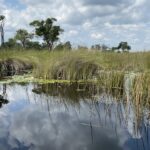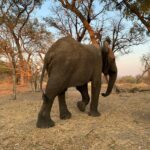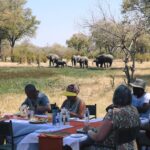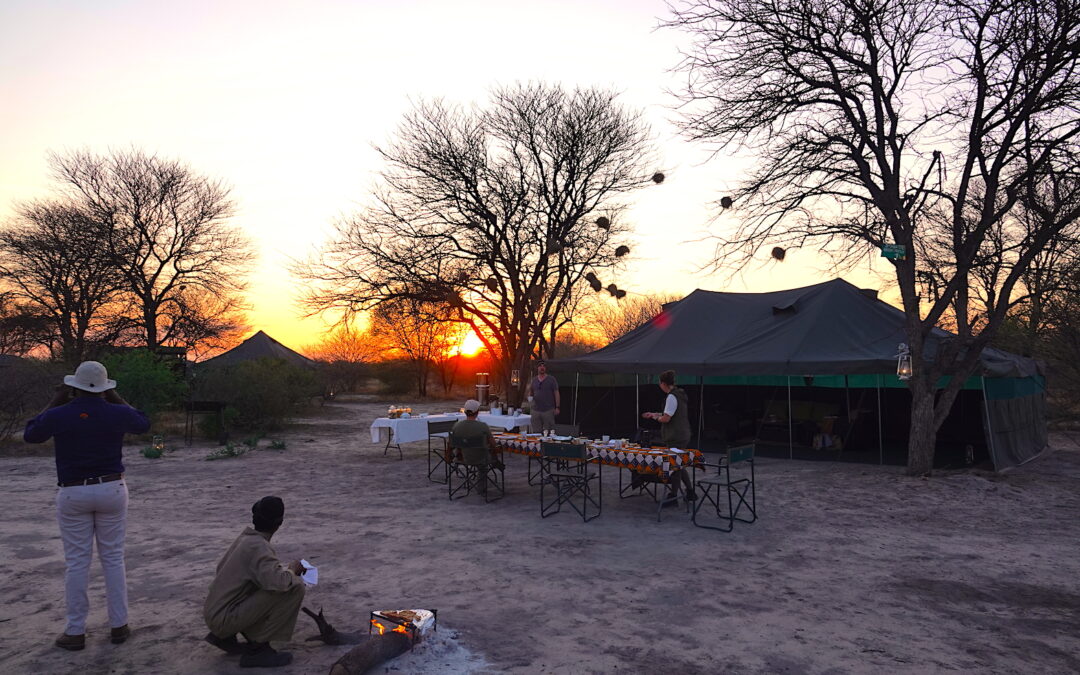
Feb 4, 2020 | Brave Africa Safari, Most Popular Blogs, Safari Tips
When planning your Botswana safari, should you choose a mobile safari or a safari lodge? What’s the difference and which one is best? Of course, we are biased toward a Brave Africa luxury safari, but we know it is important to shop around. So, we are here to help you out.
Both a mobile safari and safari lodge offer amazing experiences that you’ll remember forever. The difference is in the type of experience you’ll have. They’re not as different as you think, but there are some key things you should be aware of before you make the right decision for you and your family.
To get started, we’ll break down the key differences between a Botswana mobile safari and a safari lodge and then leave the decision up to you. (more…)
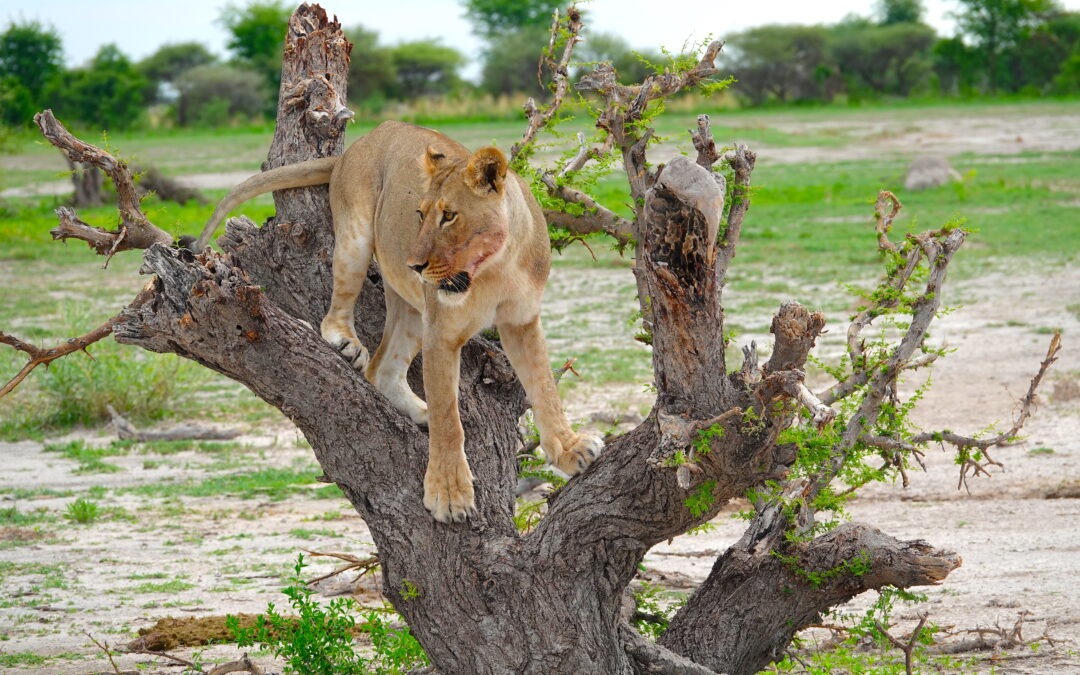
Jan 29, 2020 | Adventure Safari, Brave Africa Safari, Safari Tips
One of the first questions we get whenever we talk to someone new to safaris is, “Is an African safari safe?” We immediately assure them that it’s very safe, but we know that the word of safari enthusiasts may not be as reassuring as you would like.
So, to help you determine for yourself if an African safari is safe, we’re going to delve into the main arguments we hear over and over again. (more…)

Jan 8, 2020 | Animals of Botswana, Brave Africa Safari, Most Popular Blogs
The first question we get whenever someone begins the booking process with us is, “When should I visit Botswana? Is there a best time of the year to go on safari?” It’s a good question and it depends on where you’re visiting in Botswana. The Kalahari Desert and Okavango Delta are vastly different and respond to the seasons in different ways. We recently had the privilege to experience that difference for ourselves at the end of December.
However, before we delve into our 7-Day/6-Night Kalahari Desert region experience, let’s explain why we tried it out in the first place.
Rainy Season and the Okavango Delta
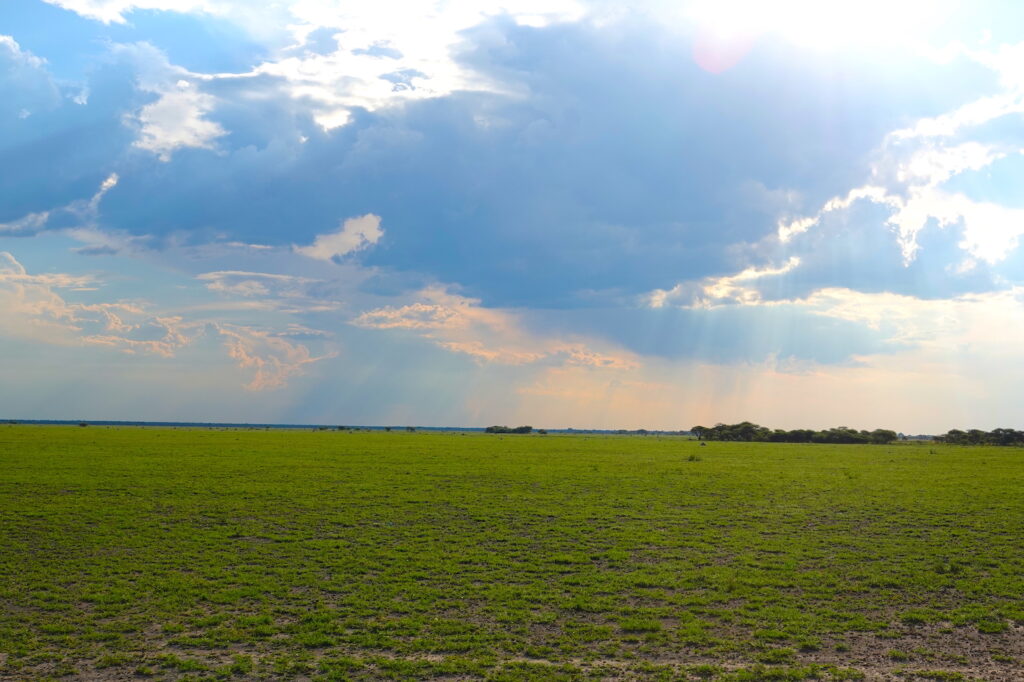
While we’re biased and don’t think there’s ever a truly bad time to go on safari, there are some months that are less than ideal. For example, the rainy season.
From December through March, Botswana becomes a water-flooded wonderland, which is essential for the eco-system of the Delta but can make your safari less enjoyable even with our ponchos to help keep you dry. The good news is that, most often, the rain is in the early morning and evening, which means midday on your all-day game drive should still be beautiful weather.
The main problem with the rainy season is that some sections of the Okavango can become impassible. For example, we cannot offer our typical 10-day safari during the rainy season because the road to get to Savuti is underwater. Instead, we mix it up with more time in Moremi and Khwai.
To combat this rainy season problem, our team wanted to try out something totally different. We decided to test out a new route with three camps around the Kalahari Desert area: Nxai Pan, Makgadikgadi Pans, and Central Kalahari.
Brave Africa and the Kalahari Desert
First: a little Botswana geography lesson.
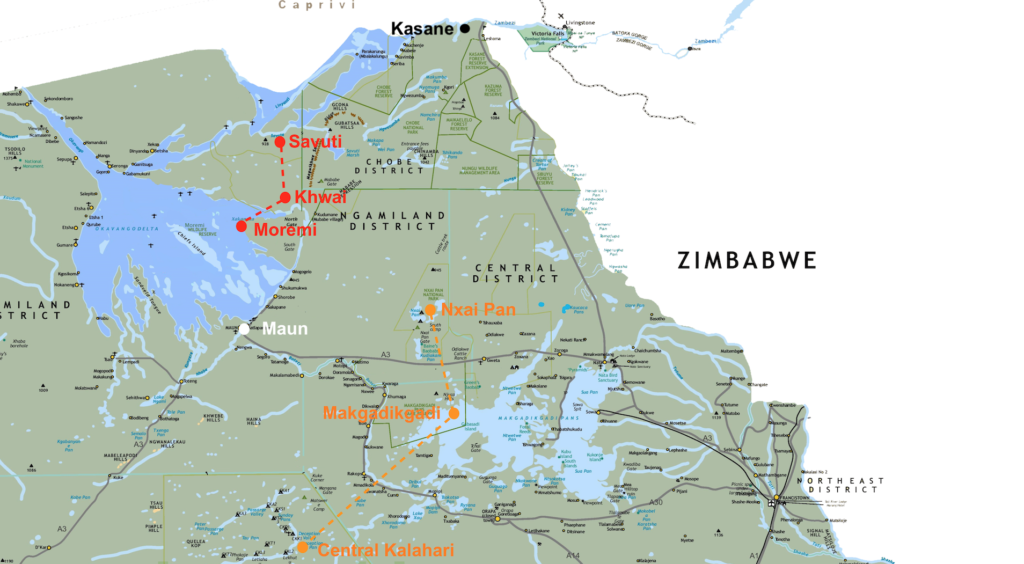
Almost all Brave Africa safaris begin in either Maun or Kasane (Maun for trips beginning via South Africa, Kasane for trips beginning via Victoria Falls). These two airports (in black and white on the map) are your starting points for getting to your safari destination.
The Red Route – Inside the Okavango Delta
For our typical route (the red dots), you would take a bush flight from the airport (Maun or Kasane) to either Savuti or Moremi to begin your safari with us. We would then drive you along the red route (north or south) until you spent three days at each location and really gained a taste of the Delta.
However, as we explained above, Savuti is disconnected from Khwai and Moremi during the rainy season (December – March), so we’re limited to a smaller area of the Okavango. It’s still a great experience since that area is so incredibly wildlife dense, but for some guests, it can be disappointing not to visit Savuti and Chobe National Park.
The Orange Route – Visiting the Kalahari Desert
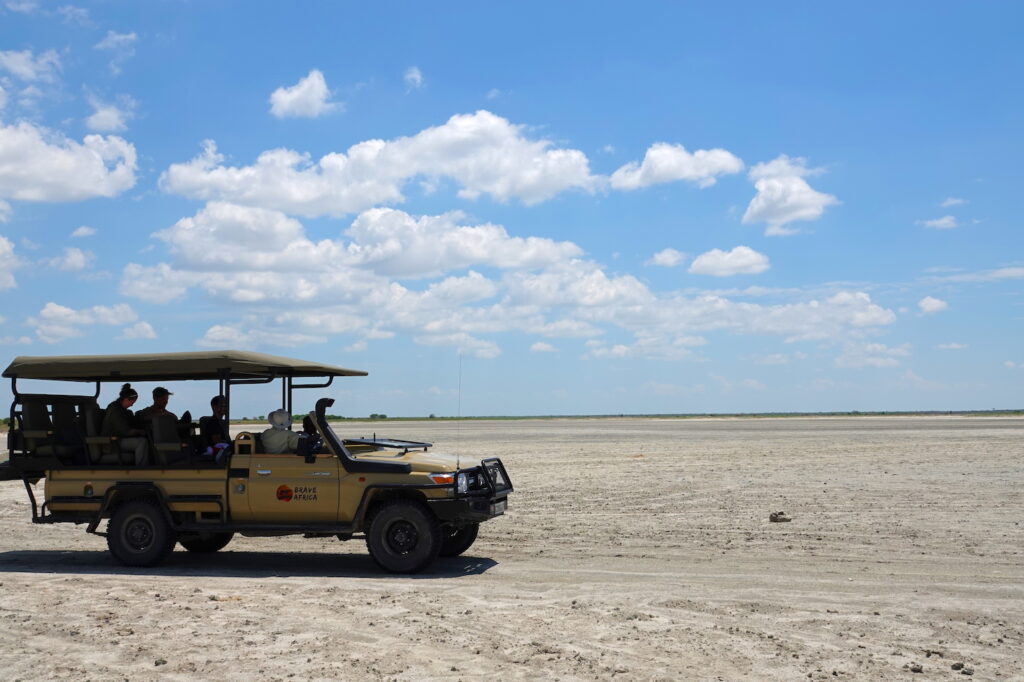
That’s why we decided to try out a new southwestern route, which we’ve outlined in orange: Nxai Pan, Makgadikgadi, and Central Kalahari.
As you can tell right away, this is a much different region of Botswana and that offered quite a surprise for our team. Because of its very dry landscape, the rainy season is actually peak season for these areas, and we had hoped it would offer our guests an exciting alternative to the Okavango Delta without the rain. And that was definitely the case.
During mid-December, when heavy rains hit Maun and the Okavango, we remained fairly dry on in the Kalahari area—only enjoying one amazing thunderstorm. So, the area definitely passed our test for dryness.
However, in the end, it’s not a route we’ll be offering Brave Africa guests any time soon. While there were many things to love, there were also many negatives that we felt would detract too much from a quality safari.
Here’s what we discovered: the good and the bad.
Mobile Safaris in the Kalahari: the Good and the Bad
So, what was it like to go on a mobile safari in the Kalahari region? It was very different from the Okavango in both good and bad ways. Unfortunately, by the end of the trip, we felt the negatives outweighed the positives, at least for us, and here’s why.
GOOD: Unique Animals
Our favorite aspect of visiting the Kalahari region was getting to see unique animals that you don’t find in the Okavango. For example, instead of Impala everywhere, we were overwhelmed with Springbok and Oryx (Gemsbok). These are desert-dwelling antelope that you won’t find in wetter areas. We also saw a ton of Steenbok (the smallest antelope) and even some Red Hartbeest.
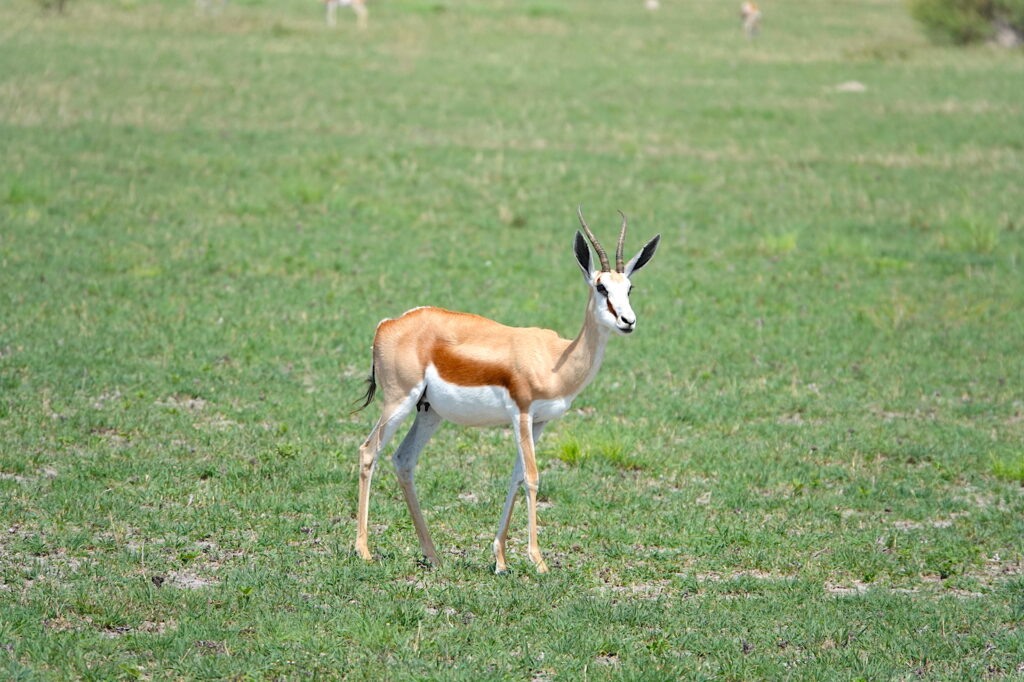
Springbok
On the predator side, these areas are also a haven for black-backed jackals, bat-eared foxes, and highly rare predators such as Brown Hyena. For birds, there are Kori Bustards (the largest flying bird) everywhere, as well as various eagles and hawks and vultures.
This was all very different from what we were used to in the Okavango, which made it exciting.
BAD: Long Travel Days
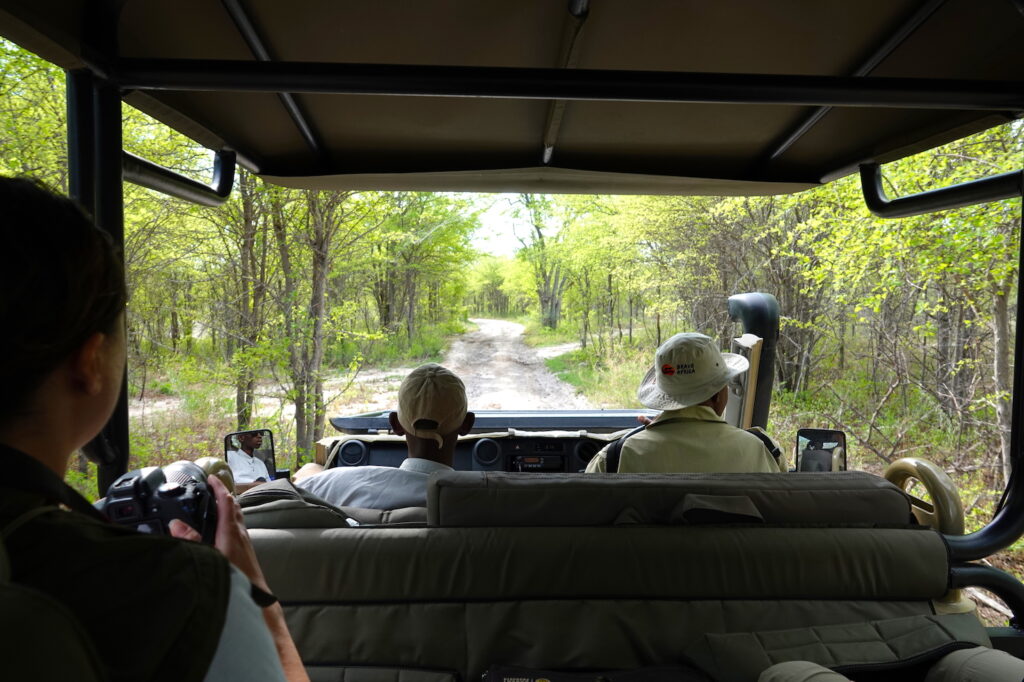
As easily evidenced via the map, going on a mobile safari in the Kalahari area requires a lot more driving between camps. On camp move days, we had to travel over 100 km to get to our next camp and much of that travel was on roads.
This meant that, as a guest, you would not be able to enjoy an all-day safari on camp move days. Instead, you’d be stuck spending a good four to five hours on a dirt road, driving at 50 km/hour, waiting to get to something you can see and enjoy.
The driving between camps was not only taxing on our guests, but it was incredibly difficult for our staff. Trying to get all of our ultra-luxury camp supplies to the next location in time and safely was a chore.
GOOD: Mesmerizing Landscapes

Baines Baobab
Every day on our 6-night safari in the Kalahari region, someone in the Land Cruiser would say “Wow!” when it came to the scenery. We were all so used to seeing rivers, Mopani forests, and sweeping grasslands in the Okavango, that to see desert salt pans as far as the eye could see was something else.
There were a few areas, such as Baines Baobab, that literally took our breaths away. It felt like we were on a completely different planet. It was hard to imagine things living in such harsh but beautiful landscapes, and we thoroughly enjoyed the scenery.
In particular, we all loved the many Baobab trees, which could be found throughout Nxai Pan. Every time we saw one, we had to stop and enjoy its beauty, shade, and majesty.
BAD: Low Animal Density
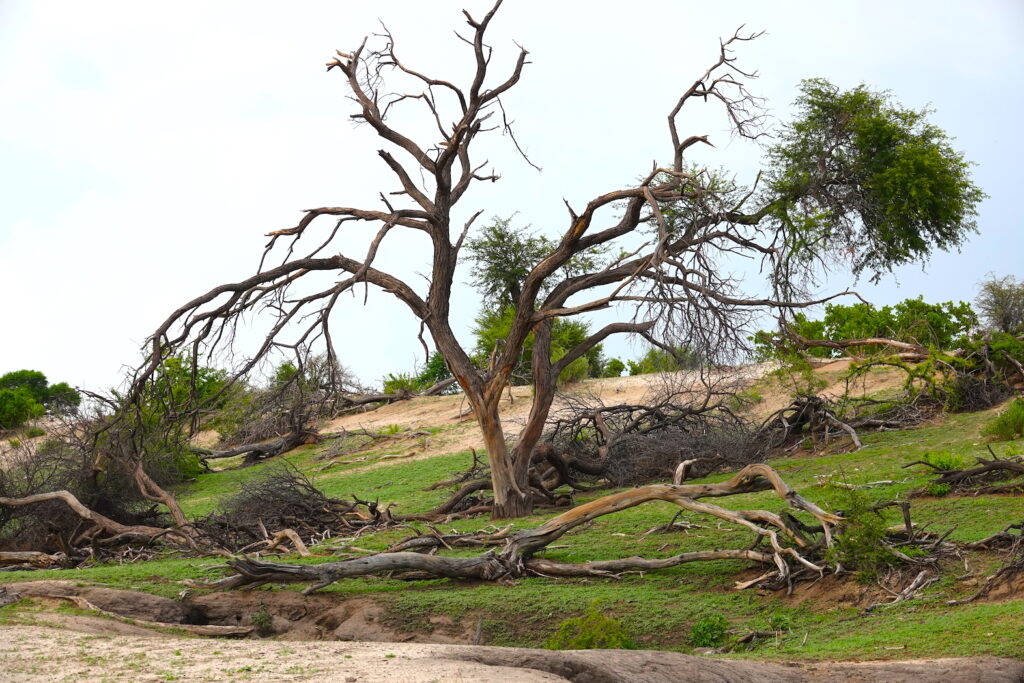
If you’ve ever taken a Botswana safari in the Okavango, you know that animals are everywhere. You won’t be with lions, leopards, or wild dogs constantly, but there’s a fairly regular stream of antelope, elephants, buffalo, wildebeest, and more. You won’t go more than an hour without seeing something in the Delta.
In the Kalahari, there were times that we drove for hours and hours without a single sign of wildlife. No birds, no antelope, nothing. The peace was incredible. We were seriously on our own for hours at a time, but if you’re going to Botswana to see the animals, this area could be fairly disappointing.
For example, in our seven days on safari, we only saw elephants twice and we only ever saw Bulls; we never saw a breeding herd. And in Makgadikgadi, it’s unfortunate to say, but we saw more corpses and livestock than Botswana wildlife.
GOOD: Fewer Tourists
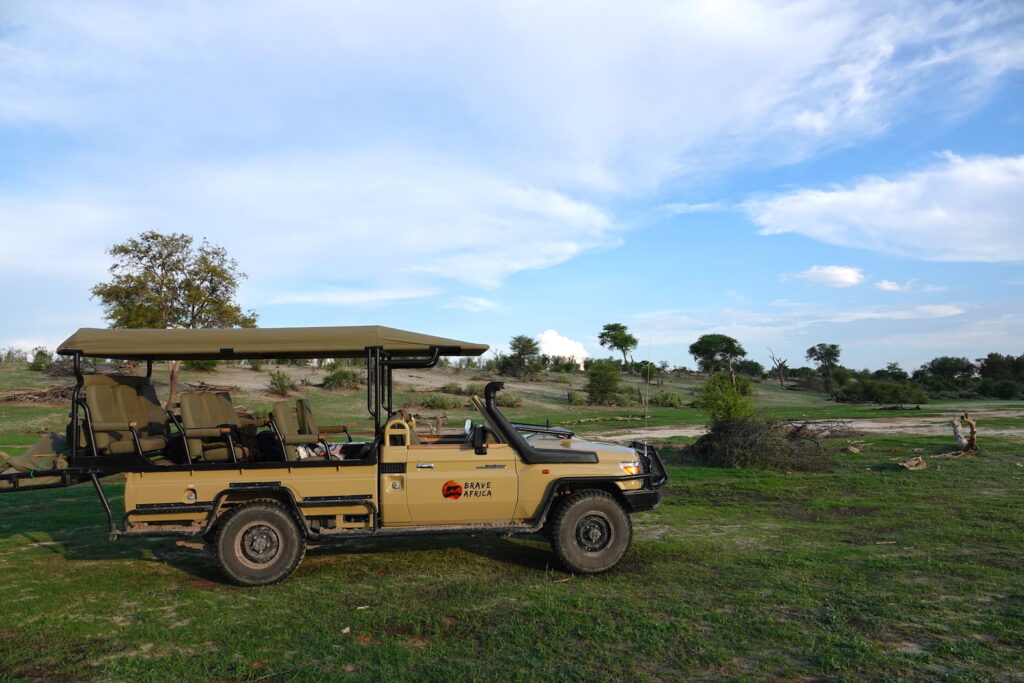
If you’re looking to get off the beaten track, the Kalahari region is the area for you. In both Nxai Pan and Makgadikgadi we rarely, if ever, saw another car. We were alone in the parks and able to explore as much as we wanted without having to worry about any other camps or self-drive vehicles.
Central Kalahari had more camps, but still far fewer than you’ll have in the Okavango. We still went hours without seeing another soul.
BAD: Heat
There’s hot and then there’s hot. Imagine 35 degrees Celsius (95F) with no shade around, no water to cool things down, just unrelenting sun and heat. There were times that we didn’t stop for lunch until 3 pm because we couldn’t find a single tree tall enough to offer shade to eat.
At least in the Okavango, there’s always a river, marsh, or watering hole nearby to offer a reprieve from the summer heat. In the Kalahari, you have to be willing to brave locations where there’s not a single plant above waste high for as far as the eye can see.
Going on Safari in the Kalahari Desert – Final Thoughts
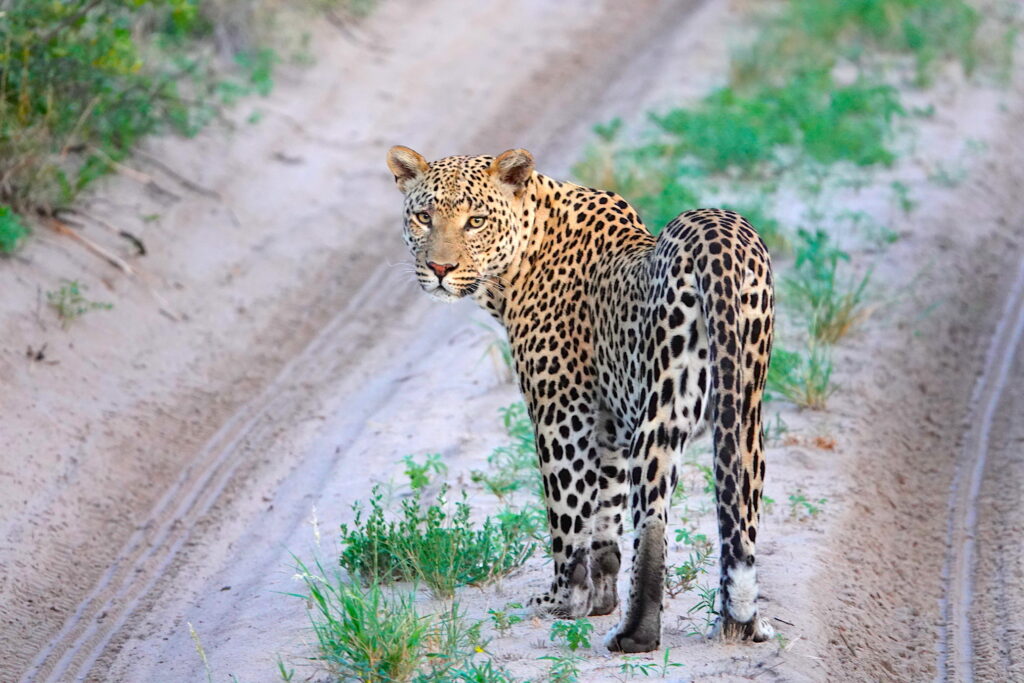
In the end, while we enjoyed our time on safari in the Kalahari region, it is not a location we think our guests would enjoy as much as the Okavango. For first-time safari-goers or safari enthusiasts who are visiting Botswana for their first or second time, the Okavango Delta is a much better choice. There’s more diverse wildlife and denser populations of wildlife.
However, we definitely recommend that you take the time to visit a camp in the Kalahari region and spend two-to-three days exploring. The pans should not be missed and there are many great camps in this region where you can fly in and fly-out before joining up with Brave Africa for the remainder of your safari in the Okavango.
In particular, we recommend Nxai Pan and Central Kalahari. For example, African Bush Camps offers a unique Migration Expeditions in Nxai Pan solely during the rainy season.
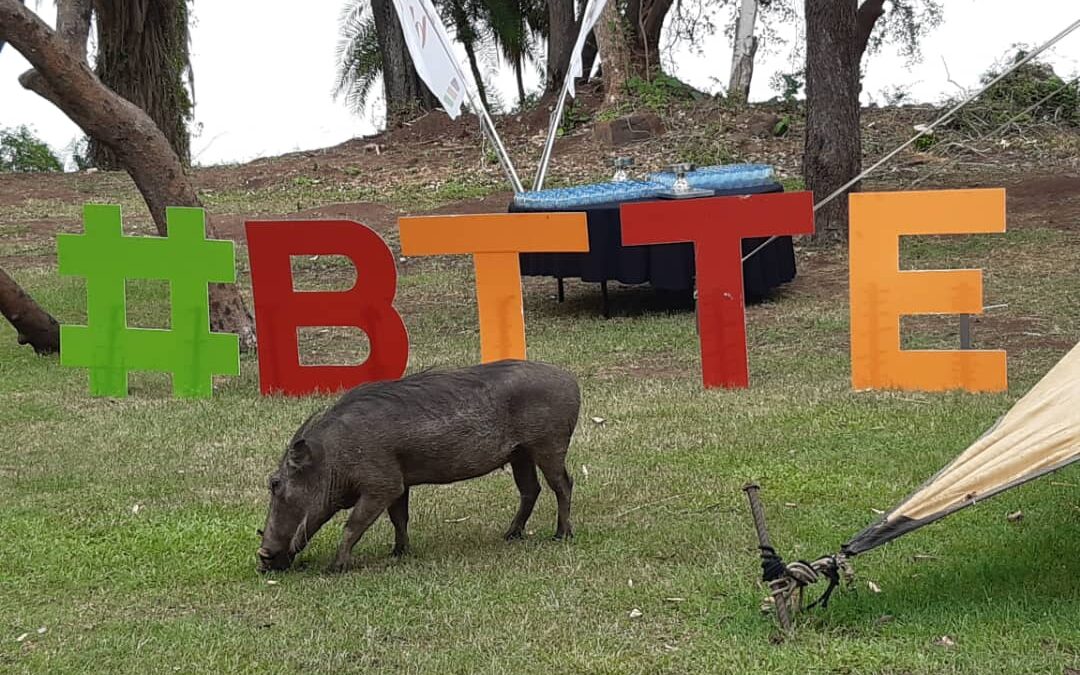
Dec 8, 2019 | Behind the Scenes, Botswana News, Brave Africa Safari, Conservation
The past two months have been hectic at Brave Africa safari. After our first official safari launch in September, our team hasn’t had a moment to relax. Instead, we’ve focused on building deeper relationships throughout the safari and travel industry, including attending BTTE (Botswana Travel & Tourism Expo).
The great news is that we have an incredible team of individuals who have worked tirelessly to make this possible. They’ve given 1000% of themselves to meet new people, rekindle existing relationships, and introduce Brave Africa as the new ultra-luxury mobile safari to book in 2020 and beyond.
Here’s a little bit about what we’ve been up to during this exciting time behind the scenes with Brave Africa safari.
Giving Back to the Community
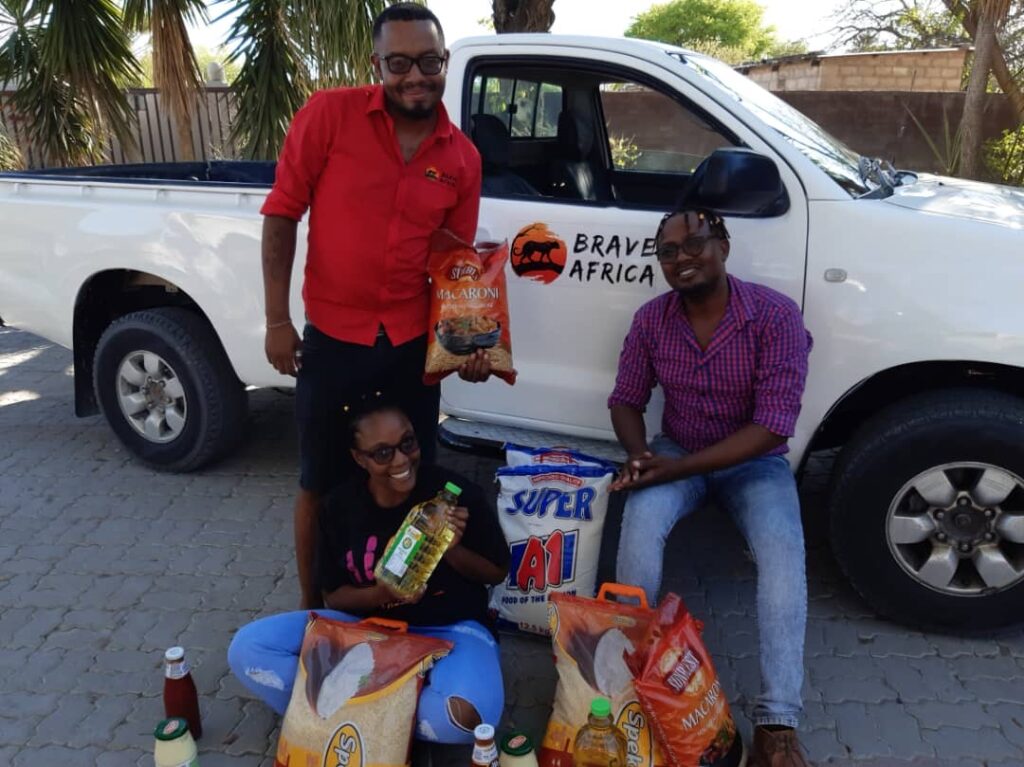
Brave Africa’s guides, Wina and Moses, dropping off food items to Safari Destinations.
In November, we had the opportunity to start giving back to the Botswana community. This is a huge piece of who we are and what we believe in. We do not want to be just another safari focused on making money and moving tourists in and out of the country. We want to make a difference not only for the wildlife but also for the Botswanan people.
We plan to do this moving forward by donating $5 a day from every guest’s trip with us to various conservation and community charities. Our team is currently doing extensive research to find the best non-profits to give to, and we’ll have that list available soon. However, we already had the opportunity to help the elderly population in Maun, and we’re so glad we got to participate.
Safari Destinations, one of Botswana’s premier travel agencies, held an annual charity drive to collect needed items for older individuals within the Maun community who require assistance. Our team got together and purchased massive bags of food goods to do our part.
For our Brave Africa safari staff—all of whom are Botswanan natives—taking care of your elders is the responsibility of the community. They shared with us funny stories of being kids and being charged with walking to the store for an elder to purchase their groceries, whether they were related to the individual or knew the individual well or not. Participating in this charity event made a lot of sense and was special to our team.
A Trip to Victoria Falls
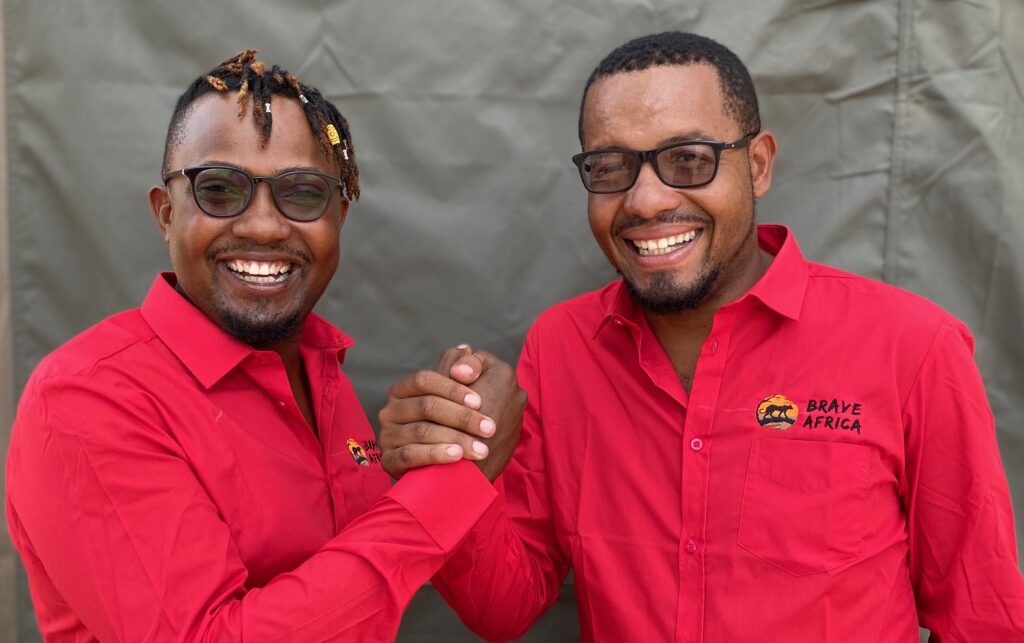
Tabona Wina (left) and Moses Teko (right)
The following week in November, our team headed up to Zimbabwe and Victoria Falls to meet with travel agencies throughout the area and start building relationships. This trip was made possible thanks to Shelley Cox at Africa Conservation Travel.
Africa Conservation Travel is a travel agency that is focused on offering safari experiences dedicated to sustainable tourism and conservation-conscious itineraries. Their mission is to create awards about protecting and conserving the wildlife and habitats during every trip.
Shelley has been an integral piece of Brave Africa safari since the very beginning. She is a good friend of our owner, Tabona Wina, and has offered our team priceless guidance. We are beyond grateful to her and her company.
Thanks to Shelley’s connections and the hard work of our team, we were able to introduce Brave Africa to other members of the safari industry. We loved getting to share our mission and vision and to tell our story to travel agencies who will help us connect with guests who share our values from around the world.
Building this base of support is critical to our eventual success and helping safari-goers discover us.
Thank you for taking the time to meet with us!
Botswana Travel & Tourism Expo (BTTE)
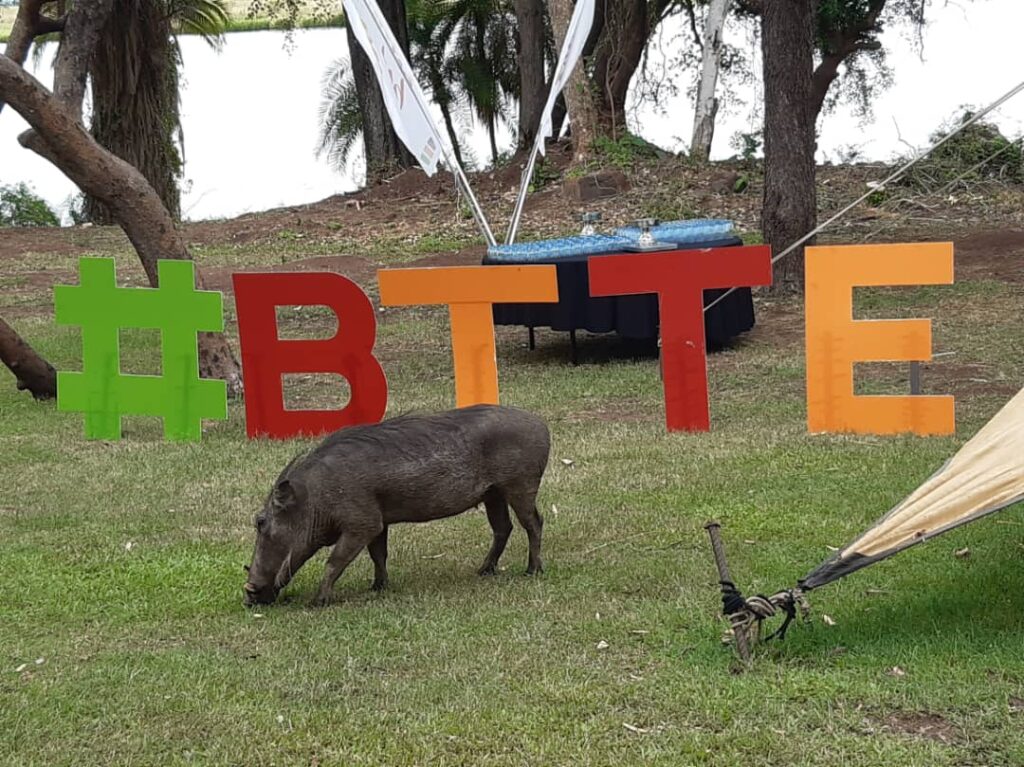
Botswana Travel & Tourism Expo
Finally, we kicked December off with a bang with Botswana’s largest travel and tourism expo: BTTE. This unique, annual event offers an opportunity for the greater European travel industry to establish relationships and business partnerships with Botswana’s tourism industry. Every safari company, travel agency, and tour operator in Botswana attends this networking event, and we were thrilled to take part!
Held December 2rd – December 6th, in Kasane, #BTTE19 was the event of the year. Over 280 exhibitors, including 140 local operators and 140 international operators from 33 countries around the world participated. Attendees came from all over, including Argentina, United Arab Emirates, Israel, and throughout Europe.

Pano of the BTTE tent
The goal of the event is to introduce the many incredible tourism opportunities available in Botswana and to demonstrate the unique manner in which the country approaches tourism. Unlike many other African countries, Botswana is dedicated to protecting the environment and the country’s natural resources as much as possible to keep tourists coming back over and over again.
For Brave Africa safari, BTTE was an opportunity to set up a booth where attendees could come up to learn more about who we are and what we offer. We also had a table for a “Business 2 Business” event where attendees had just 15 minutes to meet our team and get to know our product before they moved on. This was an inspiring, educational, and super productive session, where we established many strategic relationships.

Wina & Moses during the brief Business 2 Business sessions
The week-long event included presentations from experts on the Botswana tourism industry as well as the different unique areas of Botswana. There were meet-and-greet sessions, workshops, cocktail dinners, and more. It was an exhausting week, but BTTE was a fantastic opportunity for Brave Africa to establish that we are here as part of the community and proud of it.
Next Up for Brave Africa Safari
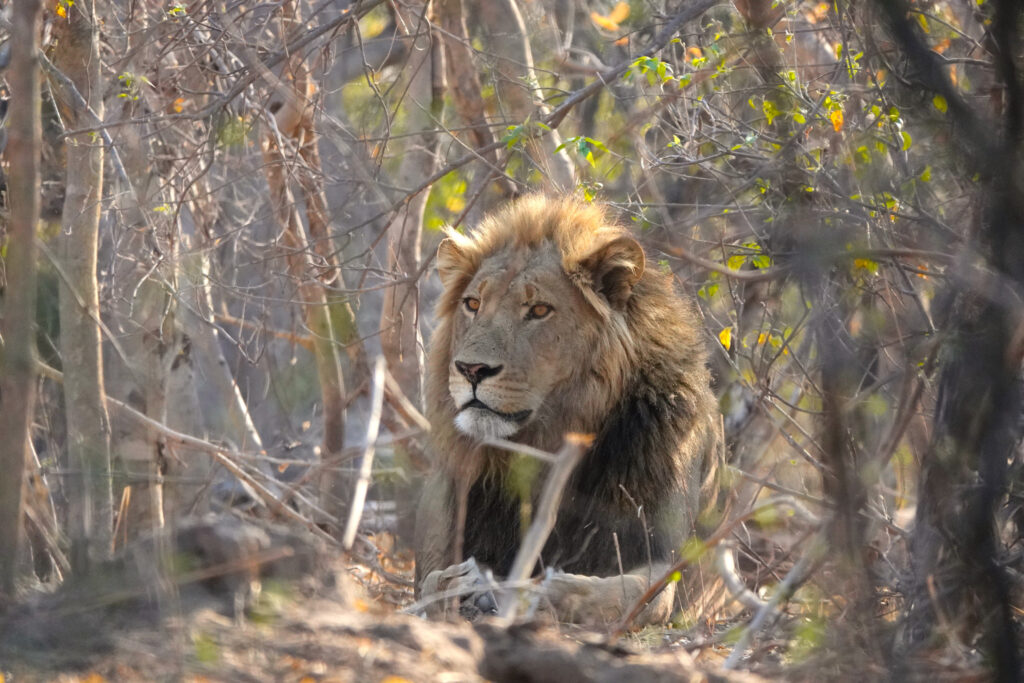
In a week, our team will be heading out into the Botswana Bush to explore a possible new Brave Africa safari itinerary—the Kalahari Desert.
This southern route will possibly be available to guests during the rainy season (December – March) when the Okavango Delta is flooded and difficult to navigate. During these months, the Kalahari is in peak season because animals are leaving the floodplains for more semi-arid regions.
December and January mark the great zebra migration in the Kalahari as well as the flamingo migration in Makgadikgadi Pan. This area is also known for its beautiful black-maned lions, brown hyena, oryx/gemsbok, and more.
We’re excited to test out this potential route for our guests in 2020, which will include:
Stay tuned to learn about our adventure in a few weeks!

Brave Africa’s table banner
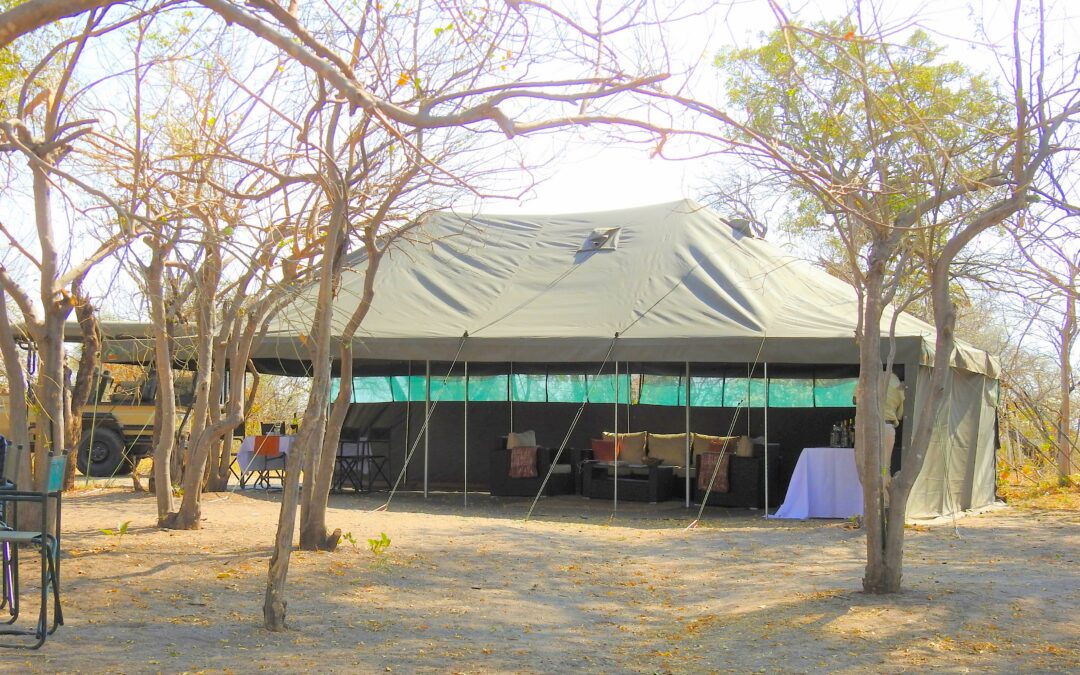
Nov 29, 2019 | Brave Africa Safari, Most Popular Blogs, Safari Tips
Before you go on a safari in Botswana, you have to do your research. Safaris are not cheap, and the last thing you want to do is try to save money and end up with a sub-par experience and a safari camp or lodge that’s far below your expectations.
The problem is that there’s both too much and too little information out there. We’ve been where you are and have spent countless hours (days!) online trying to figure out what it’s like to go on an African safari.
And trying to figure out where to stay? Forget it!
You might as well just close your eyes and pick an African safari lodge or camp at random. After all, they can’t be that different than each other. But that’s where you’re wrong.
Every Safari Accommodation is Different
While both safari lodges and safari camps offer incredible experiences and can share many of the same features, there are some major differences and similarities you need to be aware of before you make your choice. (And don’t forget to check out our similar blog about safari vehicles.)
Our goal is not to sway you toward any specific safari accommodation over another, but to provide you with an in-depth overview of your options so that you can make the best choice for you.
First, a warning…pictures are not always accurate. Some safari camps and lodges are known for photoshopping their images or putting pictures online that don’t match their typical product, but instead require hundreds or thousands of dollars in upgrades. Don’t trust what you see. Instead, be sure to do your own research and ask questions. Look for customer pictures on TripAdvisor or Google Business, or work with a travel agent who has visited the camp and can confirm that what you see is what you get.
Botswana Safari Accommodation Features
Now, before we jump into the different types of accommodations, let’s talk about a few key features of your safari vacation.
- Bedroom: Your sleeping situation can drastically change depending on your camp. Be sure to ask if you have a normal mattress bed or cots, and if the bed can be set up as a king or just two twins. Also, the size of your tent can be anything from a small dome you can’t stand inside to an extensive lodge suite and everything in between.
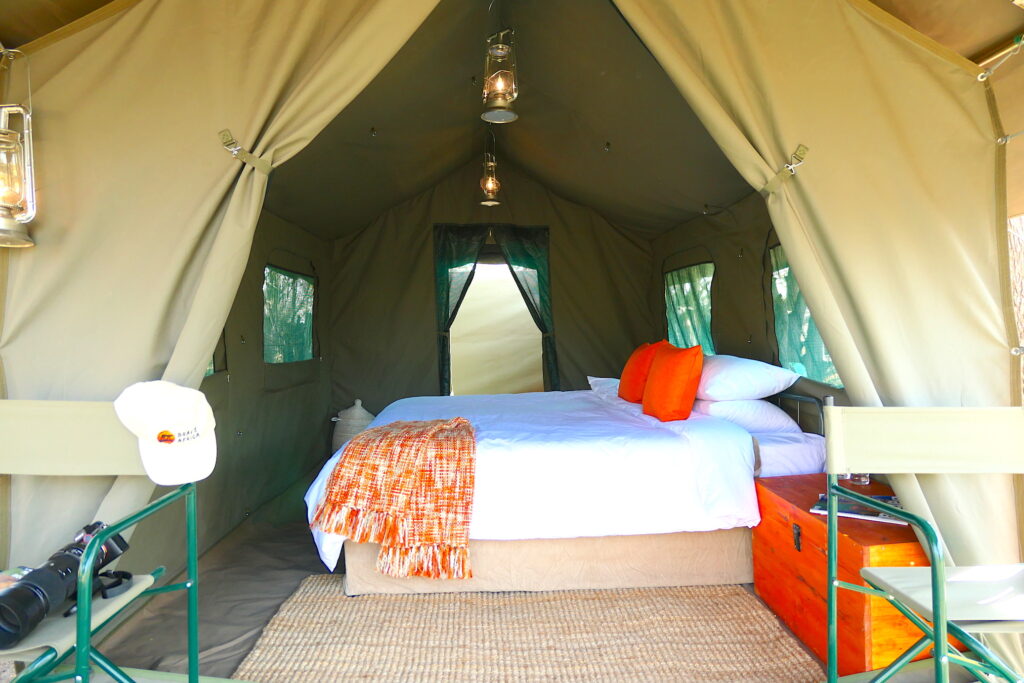
- Bathroom: Not every safari camp includes an attached toilet and bath/shower. Most safari lodges will have a flushing toilet and shower, but bucket showers are still common even in luxury lodges. For mobile camps, drop toilets are typical and showers may be communal.
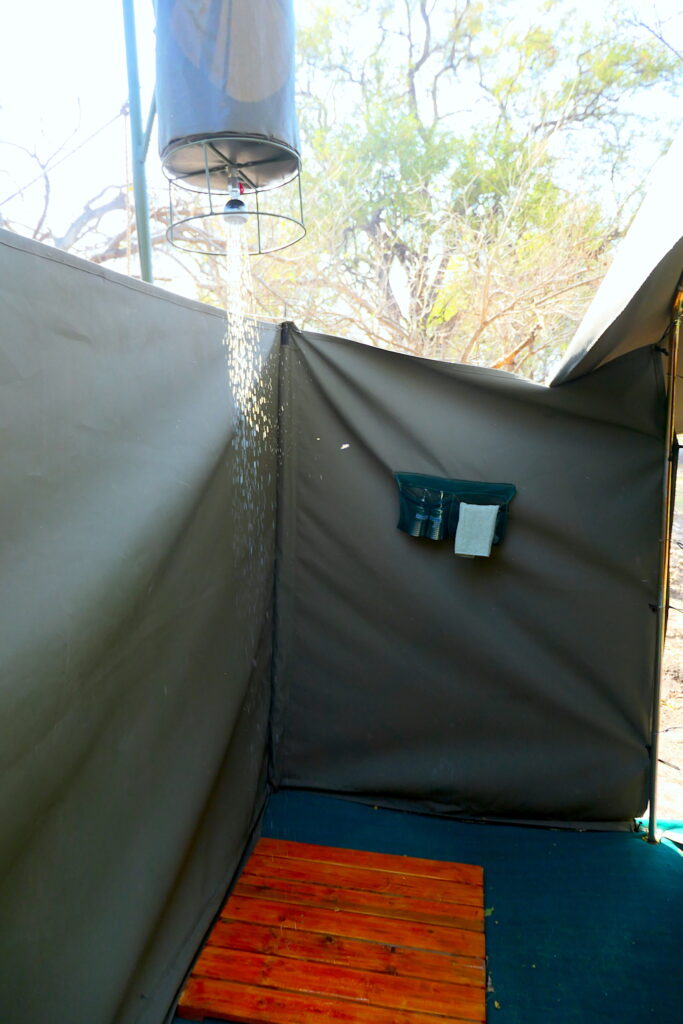
This is our custom-built shower add-on to every tent. It provides an additional 1.5 meters of space for our guests to enjoy and ensures your tent isn’t soaked during your shower.
- Shared Areas: Think of shared areas as similar to a hotel lobby or the living and dining room in your home. Every safari camp will have a campfire where you’ll hang out regularly. However, the type and size of your dining area can vary greatly, so can any sitting areas, the bar, and more. Some lodges may also have a pool.

- Power Outlet: At most safari lodges and camps, all power outlets are found in the shared areas. Your room will not have the ability to charge technology. Any charging you want to do in your room will require travel batteries and some camps may only offer charging via a car battery.
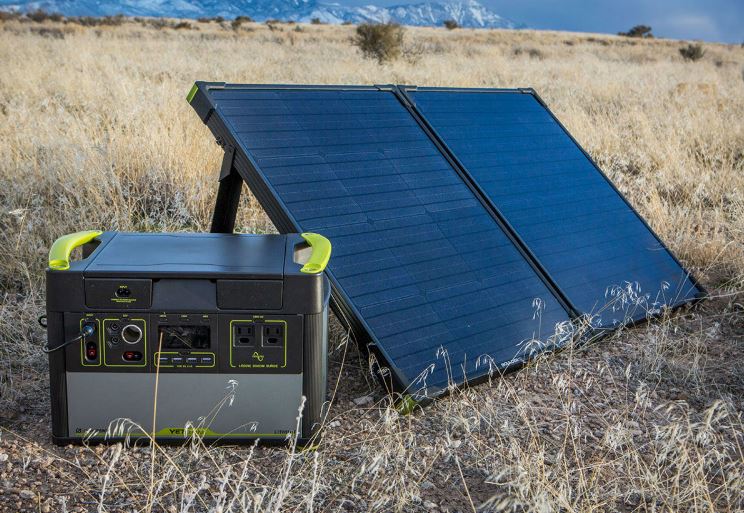
- Internet Access: Very few, if any, Botswana safari camps offer access to the internet. The goal of a safari is to unplug, so do not expect internet or mobile to work while on safari. Instead, use your safari as an opportunity to forget that the rest of the world exists. (We do have a satellite phone available for emergencies.)
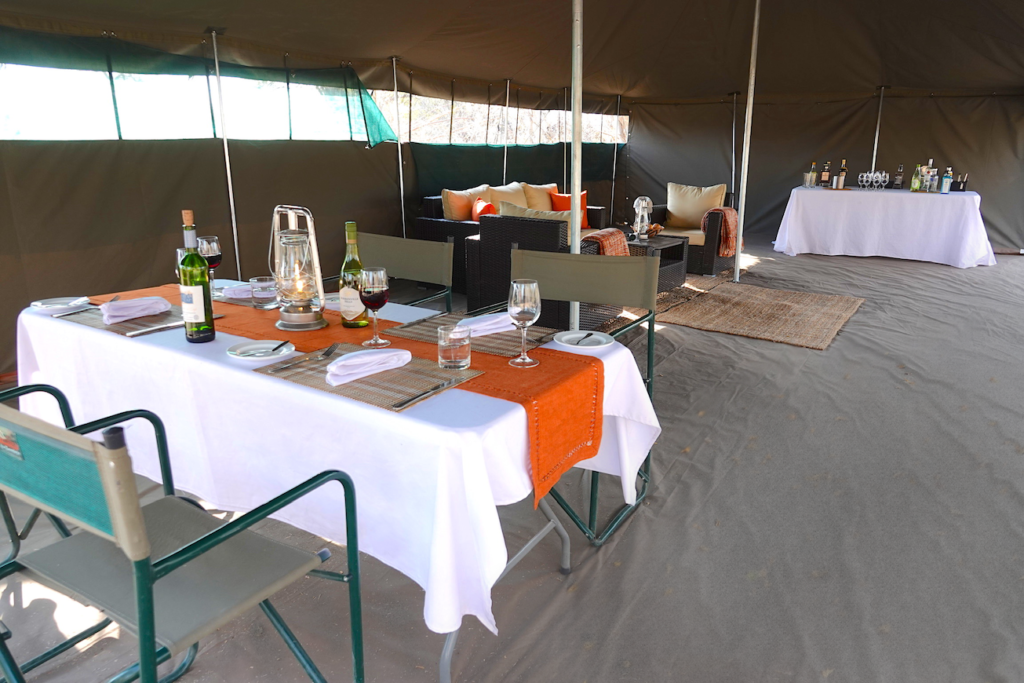
- Food: Most lodges and camps have a chef, but the type of food they serve can very. For many mobile safari camps, cooking is done over an open fire, which can drastically limit the menu. However, some mobile camps, including Brave Africa, have an entire outdoor kitchen with a full stove and oven, which means the chef can cook the same types of meals you’d find in any hotel or restaurant.
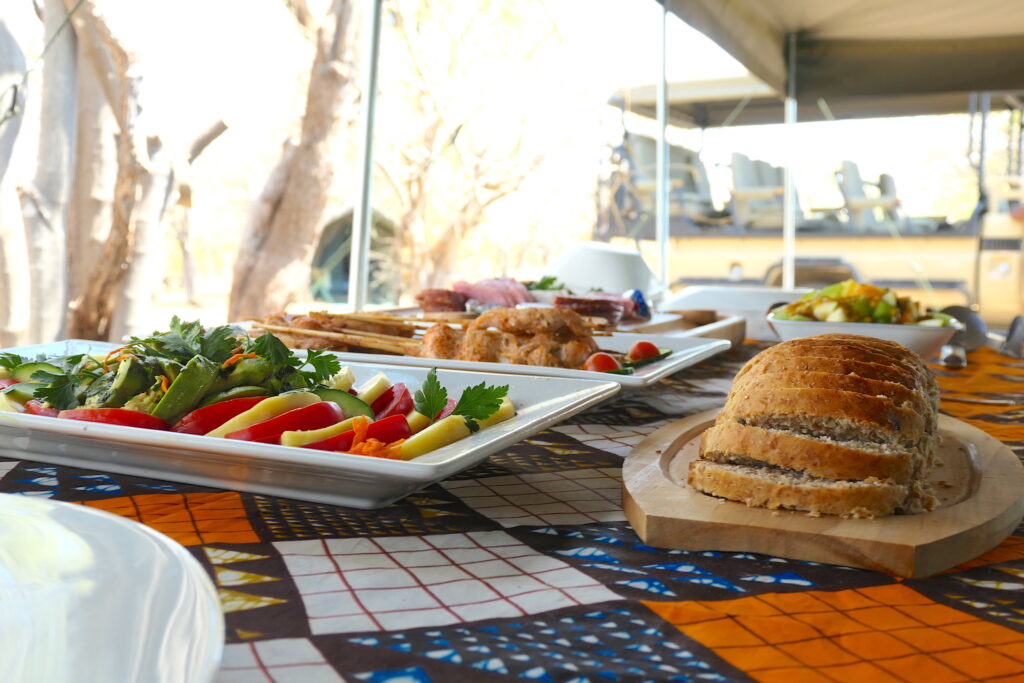
Safari Lodge vs. Safari Camp
Now, let’s look at the more specific differences between safari lodges and safari camps to help you make your final choice of accommodation. When going on safari in Botswana, you typically have three choices:
- A luxury safari lodge,
- A mobile safari camp
- A self-drive safari camp
Botswana Safari Lodge
A Botswana safari lodge is more like a luxury safari hotel. It’s a structure that remains in one location that you, as a safari guest, travel to and stay at. Typically, safari lodges will have communal areas that act like hotel lounges. There’s probably a dining hall, a reception, and a pool. Safari lodges are often built with wood, though rooms can still be canvas tents, but they offer more of a hotel-like feel. Expect:
- Suite-type rooms with comfortable beds and lots of space
- Luxury bathrooms with running water
- Large communal areas for dining and relaxing, including a pool
- Technology charging in the main communal area
- No internet access except at the more premium lodges
- Premium, chef-designed meals
All Botswana safari lodges are 100% focused on a luxury experience. They are beautifully crafted locations that are dedicated to your comfort. Guests can expect many similar features to a luxury hotel room.
Mobile Safari Camps

The second type of safari accommodation you’ll find in Botswana are the mobile safari camps. These can vary depending on how much you’re willing to pay and the type of experience you want. There are five types of mobile safari camps you can expect: budget, standard, premium, luxury, and ultra-luxury.
It’s important to note that the naming conventions we used above are NOT standard for the industry. Many standard camps use the phrase “luxury” to sell rooms. Before you take any naming at face value, ask about the type of experience you’re going to enjoy.
Budget Mobile Camping
With extreme budget mobile camping, your operator will provide tents, meals, and basic amenities, but the rest will be up to you. You may be expected to build your own very small dome tent or to participate in cooking. As for your sleeping and bathing arrangements, sleeping bags or cots are typical and toilets/showers might be shared.
Standard Mobile Camping
With standard mobile camping, the experience is a little more all-inclusive. You’ll still have small dome tents with limited amenities. However, the company will take care of setting up and tearing down your tent and all of the cooking. Think of this as camping with a team that takes care of the basic details. Bathing arrangements may still be shared between camp guests, though you should have your own drop toilet near your tent.
Premium Mobile Camping
Premium mobile camping will get you bigger tents with a little more room to move around. With these safari camps, you’ll have your own private toilet (drop) and bucket shower, typically connected to your tent. You still might sleep on cots, but all of your amenities are a little more premium, including your food—it will be cooked over a fire by a chef. You should also have a small dining tent that can be used as a shared communal area.
Luxury Mobile Camping
Luxury mobile camping upgrades all of your features. Your tent should be large enough for a King bed setup with extra room to move. The toilet and bathing amenities should be top-notch. You may have a flushing or a drop toilet, but the entire experience should feel much more luxurious—these experiences are often referred to as “glamping.” Meals may still be cooked over a fire, but should also include higher-quality ingredients and more variety. Communal areas tend to be on the small side, but they are comfortable though mainly used for dining.
Ultra–Luxury Mobile Camping
There are very few ultra-luxury mobile camps; Brave Africa is one. These are lodge-like camps where you shouldn’t feel as if you’re camping at all. Toilets are flushing, and tents are very spacious with comfortable mattresses, storage space, luxury amenities, and private on-demand bathing. As for the communal areas, they are much more expansive and include a seating area, room for dining, and a bar set up where guests can hang out at any time. Food should be cooked in a mobile kitchen with a full oven and stove, not over a fire, and premium alcoholic beverages are available.

Brave Africa flushing toilet
Self-Drive Camps
Lastly, there are self-drive camps. This is camping at its most basic. You’ll have your own car, which comes with basic camping amenities. You are in charge of everything, including all supplies. You’ll be limited to campgrounds that are open to self-drive tourists and have to share communal bathing and toilets with all other self-drive guests.
Brave Africa’s Ultra-Luxury Mobile Safari Camp vs. a Safari Lodge
| Amenities |
Standard Mobile Camp |
Typical Safari Lodge |
Brave Africa Camp |
| Bed |
Cots (twin beds) |
Typical mattress bed (king or twin) |
Typical mattress bed (king or twin) |
| Tent Size |
Very small, little room to move |
Luxury suite |
Comfortable hotel-room size |
| Toilet |
Drop |
Flushing |
Flushing toilet |
| Shower |
Bucket shower (potentially communal) |
Standard hotel shower with running water |
Private bucket shower |
| Sitting area |
Captains’ chairs only |
Comfortable couches and chairs for relaxing |
Comfortable couches and chairs for relaxing |
| Dining area |
Small tent for dining or around an open fire |
Large dining room |
Large dining room |
| Pool |
No |
Yes |
No |
| Power |
Shared power in the main area, may be limited to a car battery |
Shared power in the main area typically solar-powered |
Shared power in the main area typically solar-powered |
| Internet Access |
No internet access |
No internet access in the most premium camps |
No internet access |
| Food |
Cooked over an open fire |
Chef-created in a full kitchen |
Chef-created in a full kitchen |
https://www.youtube.com/watch?v=5QOObpI95JU
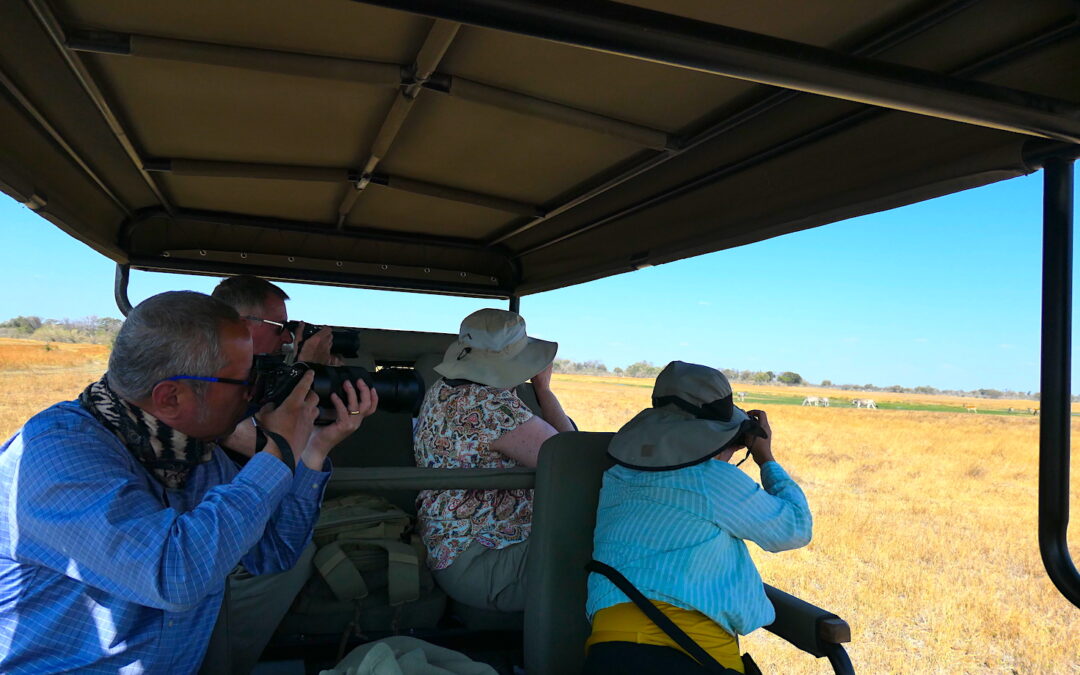
Nov 9, 2019 | Adventure Safari, Brave Africa Safari, Game Drive, Safari Tips
Safari guiding is the most critical element of a life-changing safari experience. A guide is your connection to the wildlife, your host in the Botswana bush, and your personal Wikipedia page. Without an exceptional safari guide, everything about your safari will be lackluster, and you could even put your life in danger. (more…)































